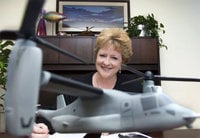Pushing Engineering and XWorx to Fly Higher: Elaine Vaught

People talk about having a five-year plan and a roadmap for their careers. I never had one. I was teaching Pascal (a now-ancient computer language) for the Women in Science program at University of Texas at Arlington. Someone at Bell asked me if I was interested in a job. I couldn’t tell one helicopter from the next, but I was immediately hooked. There’s a sex appeal about anything that can fly.
Helicopters defy the natural laws of science by beating the air into submission. Technically it’s challenging. It’s executing in the art of the near-impossible. We’re responsible for the processes that design, build, and support all our aircraft and products, as well as a technology roadmap and a long-term research and development strategy. Any time we meet a commitment to a customer, that’s satisfying. When we hit a milestone or solve a huge problem—for example, no one ever flew a tiltrotor vehicle before at the speeds that we have recently done it—that’s pretty heady.
From a technical viewpoint, the most exciting experience I had was testing equipment at an Army base airport at midnight before troops flew off to the Persian Gulf. We do important work. We do things that make this world better. We saved 54,000 people after the earthquake in Pakistan. We saved countless people after Hurricane Katrina. We’re on the cusp of a huge growth opportunity for both commercial and military development. I’m excited about re-energizing and mobilizing my team toward more of a focus on innovation and solutions for products and solving some process issues. I’m absolutely pumped up for it. Our Engineering and XworX folks are naturals for the Textron Six Sigma tool set—we have a number of black belts and green belts so there’s a lot of energy around that. We’re defining roles and tightening the processes, which gives people added enthusiasm moving forward.
I’m in the office twelve to fourteen hours a day. Eight of those are spent in meetings helping solve different problems—technical problems and career problems. During those other hours I’m committed to connecting with people to make sure obstacles and perceived obstacles are removed so they can do their jobs. I don’t feel satisfied unless I connect with people in a personal way. I think about that every day on my way home. “Did I help someone do a better job today?”
If I were to have a legacy it would be to help a group or a person take a step forward. My vision is to focus on the building blocks that will feed our aircraft much faster, investing in new technologies, leaning our processes, and getting minds around reducing development cycles in a quantum way. Twenty years ago no one thought we could put a tiltrotor aircraft in the air. It’s putting things in the air in ten or twenty years that we’re passionate about today that people don’t think is possible. When I speak to women’s groups, I encourage women who want to do something meaningful and make money to consider careers in engineering, whether in telecoms, dotcoms, or even aerospace. It’s a very challenging career but enormously rewarding. It’s not easy for women to break the glass ceiling, so I hope the work I’ve done will make it easier for my daughters to find meaningful work and get paid for it. My advice is be open to possibilities, keep a sense of humor, and always take the high road.
About the author:
Elaine Vaught was named Senior Vice President of Engineering and XworX in April 2006. She joined Bell in 1985 as an avionics software programmer and has spent the last twenty-one years working in all aspects of the rotorcraft industry.
